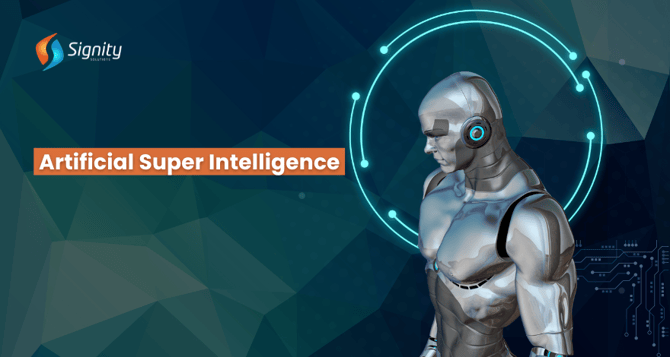What is Artificial Superintelligence?
Have you ever heard the term ‘artificial superintelligence’ and wondered what the buzz is about? Read on to discover how it can benefit your business, what the challenges are, and how to get started.

What's better than your favorite season of the year? That, combined with the trip you had been saving up for for ages. In a similar way, what can be better than algorithms that can mimic human intelligence and perform tasks as per commands?
It is the same, but with advanced technologies that can actually decipher human emotions. It is called artificial superintelligence, something the technological world has been waiting for with bated breath.
Key takeaways
- Artificial superintelligence is basically a more advanced form of artificial intelligence that possesses human intelligence and can even surpass human intelligence.
- The methods to implement artificial superintelligence are a bit complex.
- Artificial superintelligence offers benefits like more automation, amazing problem-solving skills, and a huge memory reservoir.
- There are some challenges when it comes to artificial superintelligence implementation.
Also called “Futuristic AI, "it is a hypothetical system based on Artificial Intelligence that can mimic human cognitive behavior. It was first ideated by Nick Bostrom, an Oxford philosopher.
According to Mr. Bostrom, Artificial Intelligence is perfectly capable of surpassing humans in fields like wisdom and creativity. It is said to be born out of a phenomenon called “Intelligence explosion,” which includes software evaluating itself, analyzing loopholes, and improving itself.
Artificial Intelligence vs. Artificial Superintelligence - What’s the Difference?
-
The first point of difference between artificial intelligence and artificial superintelligence lies in their general definition. Artificial intelligence refers to computer systems that can mimic human tasks like writing, reading, analyzing, and creating stuff.
On the other hand, artificial superintelligence refers to an advanced form of artificial intelligence that can improve itself based on its performance and surpass the cognitive abilities of humans. -
Examples of artificial intelligence applications include creating presentations, devising a study plan for a child, analyzing data for market research, and writing blogs with AI tools such as ChatGPT, paragraph rewriting tool, and sentence expander, etc.
Conversational chatbots developed on generative AI frameworks can even conduct interviews with potential candidates. AI technology can suggest some potential roadmaps for his firm to an entrepreneur.
Artificial superintelligence solutions, on the other hand, will encompass more intellectual depth. Let’s examine some examples of artificial superintelligence.
For example, if you speak to an ASI system regarding the ever-increasing carbon monoxide levels in the air or the AQI of Delhi in winter, it will actually suggest various ways to curb the issue. It even offers solutions to complex problems like plastic waste clogging the environment or disparity of wealth in urbanized landscapes.
-
While artificial intelligence can perform many tasks to a “T’, just like humans can, it fails to comprehend human emotions, and this can lead to unfulfilling interactions; for example, if an employee gets fired from the firm overnight, he would obviously need some emotional and mental support. However, the results are somewhat Mechanical, robotic, and lacking in depth and emotions.
Artificial superintelligence, on the other hand, can actually put itself in the shoes of someone you know and understand what they are going through. It will then speak to you just as your friend would, slowly absorbing the scenario and bringing emotions like shock and empathy to the table.
Related Read: Top 15 Artificial Intelligence Applications in 2024
How to Implement Artificial Superintelligence?
There are multiple ways in which Artificial superintelligence can be implemented. Understanding and making sense of the human brain should be the first and foremost mandate. Just like AI is made up of neural networks, the human brain is also composed of millions of interconnected neurons that each perform a particular function.
Understanding such a complicated structure is no easy feat, let alone replicating it. Continuous learning over time is needed to explore AI intelligence.
An already existing AI technology system can also be modified and scaled down to create an Artificial Intelligence system. Sometimes, multitudes of AI systems can be combined to tap into their vast reservoir of capacity. These systems can learn from new advancements in AI systems and improve their functionalities.
Mind Uploading is also a proposed way of implementing Artificial superintelligence. It is a subset of whole-brain emulation and involves scrapping information from an individual's brain and mimicking the exact mental or emotional state of the individual. After this process, the computer or the connected AI system responds to stimulus in the same way as the human brain typically does.
There are various ways to create an Artificial Superintelligence app, such as the bottom-p approach, the top-down approach, and the evolutionary approach.
What are the Benefits of Artificial Superintelligence?
1. Problem-solving skills
Some things always surpass the human eye, no matter what. When posed with an issue, artificial superintelligence, instead of getting flabbergasted, will try to look at the issue from different perspectives and will come up with the most effective solution.
2. Memory
For most AI technology applications, a terabyte is the standard starting point, so you can imagine what it would be like for Artificial superintelligence software. ASI systems can store large amounts of data. Nowadays, as AI models become increasingly complex, LLMs are demanding the CPU have more storage space.
3. Reasoning
Artificial intelligence has already proven to be an invincible player when it comes to basic reasoning nuances like education, induction, and abduction. AI, especially artificial superintelligence, is undefeated in any kind of resonance, such as logical, multimodal, causal, etc.
4. Creativity
Sometimes, people hit a creative block and just cannot bring new ideas to the table. The team might be stuck in a rut because of this, and the organization can become very stagnant if this issue is not resolved soon. Even before its release, the artificial superintelligence system was touted as an expert in divergent things. That is, it can make associations among far-fetched things and come up with actionable ideas.
5. Enhanced Automation
By now, we are all aware of the wonders AI, along with RPA (Robotic Process Automation), has done across various industries. From automating the signing-in process at an AI company to automating the payroll procedures, from automating processes at pharm to digitizing processes at software domains, this duo has proved to be a game-changer for companies. ASI is supposed to be even bigger and better in this aspect and take automation to a whole new level.
Applications of Artificial Superintelligence (ASI)
Even though artificial superintelligence has still not been implemented, there have been a lot of speculations regarding its applications. We know for sure-
- Artificial superintelligence would help scientists in their research work. ASI will have a vast amount of knowledge in many subjects like physics, biochemistry, and microbiology and will be a blessing in the lives of researchers and scientists.
- ASI can solve a huge number of problems like Economic crises, poverty on the global level, forest fires, extinction of species, etc.
- From designing a ship to chalking out an entire space exploration plan for scientists and astronauts, there’s little confusion about what AI technology can do in the realm of space exploration.
Challenges with Artificial Super Intelligence
1. Learning limitation
It is true that ASI learns at te speed of light year and can memorize things instantly. Yet, there are some limitations in understanding the exact reason why it arises at certain steps or conclusions. No matter how developed ASI gets, it will still be dependent on a human being for the prompts/ commands. ASI, just like AI, might have certain biases, which would make the app decision-making process pointless.
2. Hardware limitation
Nowadays, as we climb the ladder of cybersecurity intelligence, effective heat management and staying ethical are some of the challenges faced by artificial intelligence in 5-10 years. In addition, the firm should have sufficient resources and impressive project management skills if it really wants to scale its business.
3. It can be influenced
Even artificial superintelligence needs to be monitored and analyzed regularly. Governments, business owners, founders, and small groups may utilize ASI for their own selfish motives. Hence, like any other thing, the proper method to go about it is to monitor the system regularly and set custom alerts.
4. Cyber security threats
As we climb the cybersecurity ladder, effective heat management and ethical behavior are the major focus areas right now. Cyber miscreants are getting better at surpassing protective measures daily. Right now, some of the popular cybersecurity threats to Artificial Intelligence or Artificial superintelligence include phishing emails, stealing AI models, data manipulation and data poisoning, impersonation, and poisoning AI training data.
.png?width=472&height=1180&name=Cyber%20Security%20protective%20measures%20(1).png)
5. Not cost-effective
It is reported that companies spend $6,000 to $300,000 daily on AI, and artificial superintelligence is much more costly. The high costs incurred generally depend on the software or platform you choose for your Artificial intelligence company, the level of scalability you want to witness in your AI company, and the complexity of the processes you are planning to deploy.
6. Weaponization of ASI
This could prove detrimental to humanity immediately. Nowadays, AI technology is being deployed by every other organization to provide suggestions regarding their military set-up and surveillance of enemies. If this is left unchecked, it can prove very dangerous in the long term.
Which AI Systems Could Achieve Artificial Superintelligence?
1. GPT4
It is a deep learning AI model, the fourth generation of GPT, that gives sophisticated human-like responses. Generative AI models are usually trained on datasets, and the datasets on which GPT4 has been trained are huge.
Unlike the earlier versions, such as GPT 3.5 and others, GPT4 can produce huge volumes of text and write long content like articles, blogs, or landing pages. One of the most striking features of GPT4 is that it can generate responses in local dialects and has built-in imaginative skills. The earlier versions could never come up with creative pieces like poems or short scripts. It can even debug codes and then implement the dataset in GUI.
2. Palm
No technical background, but you dream of analyzing your business data and deriving insights from the same to arrive at more informed decisions. Then Palm is the right choice for you. The team claims that they are focused on business outcomes. They help you sift through your data and turn the data sets into an actionable asset. Next comes into the picture: “intelligent processing,” wherein their customizable AI technology adds value to the data sets. Lastly, their team of experienced leaders is available throughout the clock and offers professional insight whenever and wherever needed.
3. Auto GPT
Auto GPT is a Python program developed by OpenAI that generates human-like responses. One of the key features of AutoGPT is data retrieval since it can effectively scout the Internet for information. Other than text generation, it has both long-term and short-term memory and can interact with numerous external APIs. From content generation to generating data reports and customer support automation to empowering virtual assistants, AutoGPT can practically do anything.
.png?width=314&height=785&name=Autogpt%20vs%20chatgpt%20(1).png)
How to Kickstart Your Artificial Super Intelligence Journey?
The road to knowledge is endless. Even in 2024, some companies in India are not making full use of the power of AI. If you are one of them, feel free to get in touch with an AI development company like Signity Solutions.
Only an experienced team with industry experts can tell you how to implement artificial superintelligence into your business processes. One excellent way to look for a company like that is to choose one that has an established portfolio of helping firms with AI consulting services.















